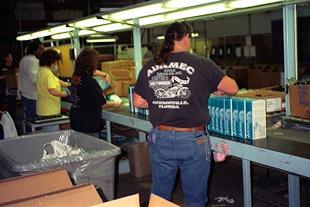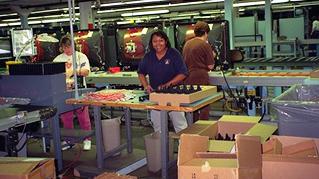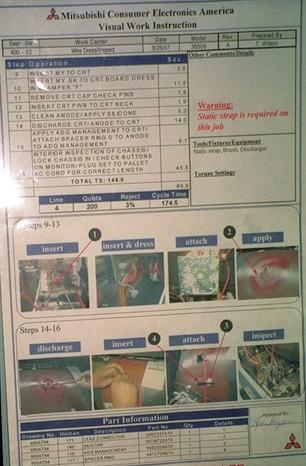
Figure 2: Packaging telephones.
We implemented bucket brigades on one of the assembly lines in one day and saw immediate improvement: Reduced space requirements because less work-in-process and increased productivity.

Figure 2: Packaging telephones.

Figure 1: Assembling subcomponents for TV's.
Jeff Lebow and his colleagues from the Georgia Tech Economic Development Institute helped us present the idea of bucket brigades to management in the morning. During lunch we chose an assembly line on which it could be tested. After lunch we shut down the line for an hour and explained the idea to the workers.
We implemented bucket brigades on a 3-person line feeding the main assembly line. This portion of the line was staffed with particularly good workers because it tended to be a bottleneck to production. (Indeed, there was a queue of partially-assembled TV's waiting for processing by this line.) The feeder line had been carefully balanced but it was impossible, given the work standards, to get a perfectly equal distribution of work, and the resulting imbalance not only slowed the feeder line but also caused subassembly work-in-process to build on a 20-foot long section of portable conveyor (the tip of which is visible in the lower left-hand corner of the photograph).

Figure 3: Detailed time-and-motion studies such as this are not necessary under bucket brigades because they are self-balancing.
In Figure 1 you can see the main assembly line moving product from right to left along a conveyor; and the 3-person subassembly line in which material flows from the lady in white to the lady in black to the lady in brown, who attaches the subcomponent to the TV. Within 30 minutes of setup the bucket brigade was running smoothly. While we watched, subassembly work-in-process inventory shrank away until the portable conveyor was empty and no longer needed. The line manager had it removed, which cleared up about 150 square feet of prime real-estate. During the next two hours the feeder line reduced the queue of waiting TV's until it was clear that the feeder line was no longer a bottleneck.
Subsequently, Mitsubishi reorganized the workers packaging cellular telephones to work by bucket brigades and saw similar improvements (Figure 2).
The industrial engineers at Mitsubishi had done as good a job as anyone could expect. For example, Figure 3 shows some of their work: the tasks assigned to one of the work stations, with photo's of the steps required and standard task times. But it is this sort of careful and expensive IE work that is rendered unnecessary by bucket brigades, which achieve better balances because they are self-adjusting and are based on the actual time to do the work, rather than on estimated or "standard" times.